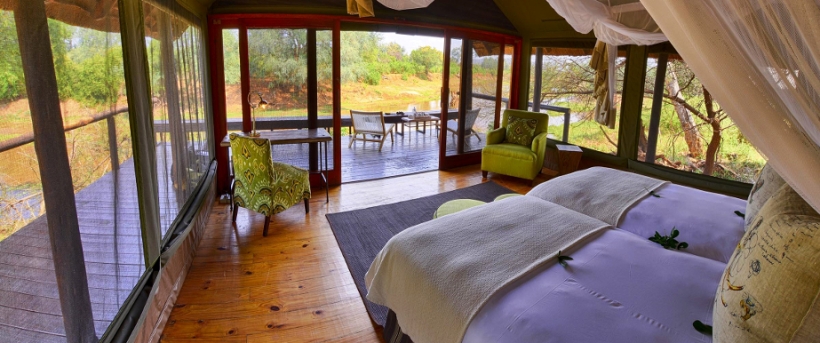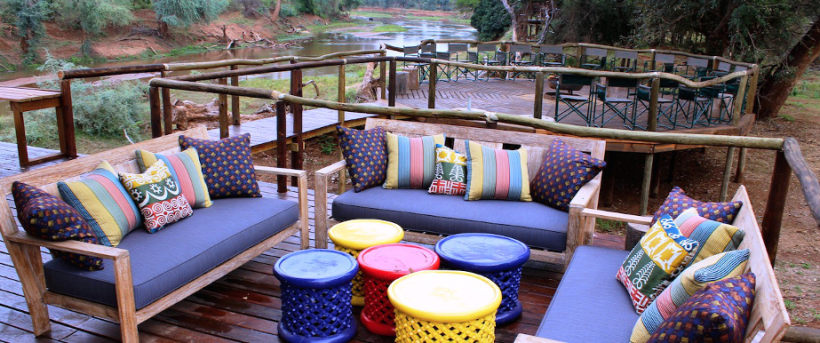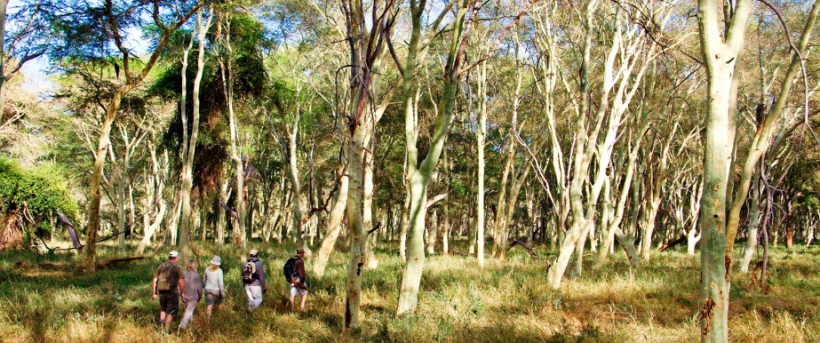Pafuri Camp (Northern Kruger National Park, Limpopo Province) South Africa
Location:
Pafuri Camp is situated between the Limpopo and the Luvuvhu Rivers in the northern sector of the Kruger National Park, in a 24 000-hectare area called the Pafuri or the Makuleke. This area is the ancestral home of the Makuleke people and is one of the most diverse and scenically attractive areas in the Kruger National Park. This area is certainly the wildest and most remote part of the Park and offers varied vegetation, great game viewing, the best birding in all of the Kruger, and is filled with folklore of the early explorers and ancient civilizations.
It is well known for its fever tree forests, beautiful gorges and Crook’s Corner, where the Limpopo and Luvuvhu rivers and three countries, Zimbabwe, South Africa and Mozambique, meet. The region is considered one of Kruger's biodiversity hotspots, with some of the largest herds of elephant and buffalo, leopard and lion and incredibly prolific birdlife.
Pafuri Camp caters for the traditional Kruger Park visitor and is the only camp accessible to self-drivers in the extreme northern sector of the Park. Being so different from the rest of the Park, it complements the scenery and experience offered at the lodges in the southern Kruger and the Sabi Sands. Travelers visiting the lodges or camps in the south can experience the Kruger in its entirety by including the Pafuri / Makuleke region in their itineraries.
Accommodation:
The camp has 20 tents, six of which are family tents sleeping four people.
Each tent is on a raised platform two meters off the ground and joined by elevated walkways. This allows wildlife to move undisturbed to and from the river, and also catches the breeze moving through the tree canopy overhead.
The bathroom is en suite with both indoor and outdoor showers for those who would like to bathe under the stars!
Facilities:
Dining and bar area are under a canopy of majestic ebony
trees.
Large swimming pool
Dinners served in a
traditional style boma under the stars, on wooden decks
overlooking the Luvuvhu River or indoors under thatch.
Camp offers a fully stocked bar with a good selection of
South African wines. The costs of these will be billed to
your room and are payable on departure.
Game Viewing / Activities:
Activities in the Makuleke / Pafuri area are extremely varied and interesting. Game drives in open 4x4 vehicles, night drives, walking safaris, hides (including some that will cater for sleep-outs) are all part of the range of activities that are on offer.
One of the most important aspects of this area is its palaeo-anthropological history, with its plethora of evidence of early human ancestors stretching back some 2 million years ago, through the Stone Age and into the Iron Age about 400 years ago when the Thulamela dynasty ruled in this area. This dynasty built incredible structures that are not dissimilar to that found in the Great Zimbabwe. Throughout the concession, there is evidence of its human inhabitants, in the form of rock paintings and artifacts – under many a baobab are Stone Age hand tools, such as hand axes, to be found.
The Pafuri region boasts fully two-thirds of the Kruger’s wildlife and vegetative biodiversity, with many large mammal species and incredibly prolific birdlife. It is famous for the large herds of elephant and buffalo that are resident most of the year round, which concentrate in particular around the permanent waters of the Luvuvhu River in the dry winter months. Cheetah have been sighted hunting the strong population of nyala and impala that live alongside the Luvuvhu system. On the easternmost boundary at "Crooks Corner" the Luvuvhu supports a large population of hippo and crocodile.
The Limpopo and Luvuvhu rivers host the highest density of nyala in Kruger and species such as eland, Sharpe’s grysbok and yellow-spotted rock dassie, which are difficult to find further south in the Park, are regularly seen here. A drive along the floodplain and riverine fringe of either of the two large rivers usually produces good general game in the form of nyala, impala, greater kudu, chacma baboon, waterbuck, warthog and perhaps grey duiker or bushbuck, while careful searching may yield the more elusive residents of the area such as lion and leopard.
Other areas hold steenbok, the agile klipspringer and herds of Burchell’s zebra. Recently, and excitingly, species such as giraffe and white rhino have been relocated to the area, from which they have been locally extinct for almost a century. The area has long been regarded as something of a Mecca for southern African birdwatchers. Some species are found nowhere else in South Africa and the serious birder will revel in being able to find Böhm’s and Mottled Spinetails, Racket-Tailed Roller, Three-Banded Courser, and Southern Hyliota. Other specials are Black-Throated Wattle-Eye, Pel’s Fishing Owl, Yellow White-Eye, Meve’s Starling and Tropical Boubou.
Accommodation Rates:-
From $425 per person per night sharing. Please contact us
for a quote and suggested itinerary.




